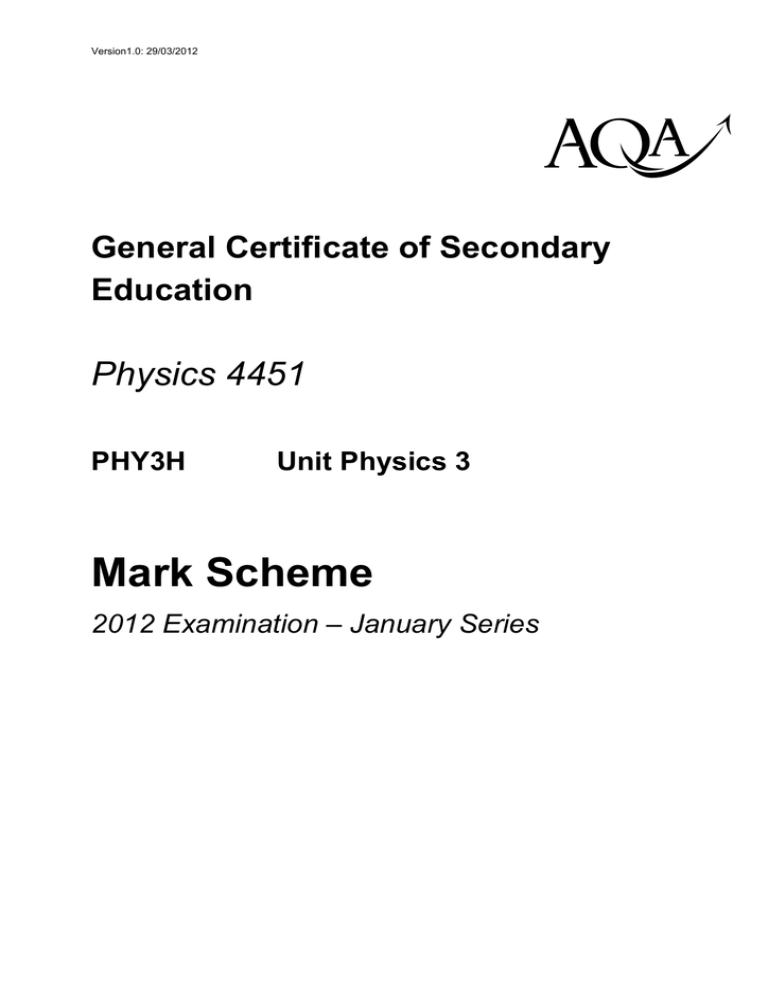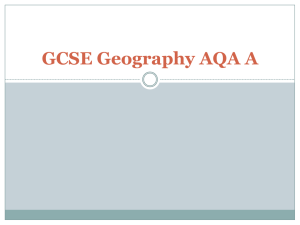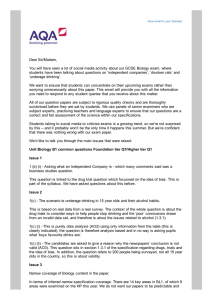
Version1.0: 29/03/2012
klm
General Certificate of Secondary
Education
Physics 4451
PHY3H
Unit Physics 3
Mark Scheme
2012 Examination – January Series
Mark schemes are prepared by the Principal Examiner and considered, together with the
relevant questions, by a panel of subject teachers. This mark scheme includes any
amendments made at the standardisation meeting attended by all examiners and is the scheme
which was used by them in this examination. The standardisation meeting ensures that the
mark scheme covers the students’ responses to questions and that every examiner
understands and applies it in the same correct way. As preparation for the standardisation
meeting each examiner analyses a number of students’ scripts: alternative answers not already
covered by the mark scheme are discussed at the meeting and legislated for. If, after this
meeting, examiners encounter unusual answers which have not been discussed at the meeting
they are required to refer these to the Principal Examiner.
It must be stressed that a mark scheme is a working document, in many cases further
developed and expanded on the basis of students’ reactions to a particular paper. Assumptions
about future mark schemes on the basis of one year’s document should be avoided; whilst the
guiding principles of assessment remain constant, details will change, depending on the content
of a particular examination paper.
Further copies of this Mark Scheme are available to download from the AQA Website: www.aqa.org.uk
Copyright © 2012 AQA and its licensors. All rights reserved.
COPYRIGHT
AQA retains the copyright on all its publications. However, registered school s / colleges for AQA are permitted to
copy material from this booklet for their own internal use, with the following important exception: AQA cannot give
permission to schools / colleges to photocopy any material that is acknowledged to a third party even for internal use
within the school / college.
Set and published by the Assessment and Qualifications Alliance.
The Assessment and Qualifications Alliance (AQA) is a company limited by guarantee registered in England and Wales (company number 3644723) and a registered charity (registered charity number 1073334).
Registered address: AQA, Devas Street, Manchester M15 6EX
2
Physics – PHY3H – AQA GCSE Mark Scheme 2012 January Series
Marking Guidance for Examiners
GCSE Science Papers
1.
General
The mark scheme for each question shows:
the marks available for each part of the question
the total marks available for the question
the typical answer or answers which are expected
extra information to help the Examiner make his or her judgement and help to
delineate what is acceptable or not worthy of credit or, in discursive answers,
to give an overview of the area in which a mark or marks may be awarded.
The extra information is aligned to the appropriate answer in the left-hand part of
the mark scheme and should only be applied to that item in the mark scheme.
At the beginning of a part of a question a reminder may be given, for example:
where consequential marking needs to be considered in a calculation;
or the answer may be on the diagram or at a different place on the script.
In general the right hand side of the mark scheme is there to provide those extra
details which confuse the main part of the mark scheme yet may be helpful in
ensuring that marking is straightforward and consistent.
2.
3.
Emboldening
2.1
In a list of acceptable answers where more than one mark is available ‘any
two from’ is used, with the number of marks emboldened. Each of the
following lines is a potential mark.
2.2
A bold and is used to indicate that both parts of the answer are required to
award the mark.
2.3
Alternative answers acceptable for a mark are indicated by the use of or.
(Different terms in the mark scheme are shown by a / ; eg allow smooth /
free movement.)
Marking points
3.1
Marking of lists
This applies to questions requiring a set number of responses, but for
which students have provided extra responses. The general principle to be
followed in such a situation is that ‘right + wrong = wrong’.
Each error/contradiction negates each correct response. So, if the number
of error/contradictions equals or exceeds the number of marks available for
the question, no marks can be awarded.
However, responses considered to be neutral (indicated as * in example 1)
are not penalised.
3
Physics – PHY3H – AQA GCSE Mark Scheme 2012 January Series
Example 1: What is the pH of an acidic solution? (1 mark)
Student
Response
Marks
awarded
1
4,8
0
2
green, 5
0
3
red*, 5
1
4
red*, 8
0
Example 2: Name two planets in the solar system. (2 marks)
3.2
Student
Response
Marks awarded
1
Pluto, Mars, Moon
1
2
Pluto, Sun, Mars,
Moon
0
Use of chemical symbols / formulae
If a student writes a chemical symbol / formula instead of a required
chemical name, full credit can be given if the symbol / formula is correct
and if, in the context of the question, such action is appropriate.
3.3
Marking procedure for calculations
Full marks can be given for a correct numerical answer, as shown in the
column ‘answers’, without any working shown.
However if the answer is incorrect, mark(s) can be gained by correct
substitution / working and this is shown in the ‘extra information’ column;
3.4
Interpretation of ‘it’
Answers using the word ‘it’ should be given credit only if it is clear that the
‘it’ refers to the correct subject.
3.5
Errors carried forward
Any error in the answers to a structured question should be penalised once
only.
Papers should be constructed in such a way that the number of times
errors can be carried forward are kept to a minimum. Allowances for errors
carried forward are most likely to be restricted to calculation questions and
should be shown by the abbreviation e.c.f. in the marking scheme.
3.6
Phonetic spelling
The phonetic spelling of correct scientific terminology should be credited
unless there is a possible confusion with another technical term.
3.7
Brackets
(…..) are used to indicate information which is not essential for the mark to
be awarded but is included to help the examiner identify the sense of the
answer required.
4
Physics – PHY3H – AQA GCSE Mark Scheme 2012 January Series
PHY3H
Question 1
question
answers
extra information
mark
1(a)
aluminium cannot be magnetised
accept aluminium is not magnetic
1
“it” refers to aluminium
do not accept aluminium is not
easily magnetised
reference to conduction and
aluminium negates mark
iron can be magnetised is
insufficient
1(b)(i)
10 to 50
either order
1
1(b)(ii)
(data is) anomalous
accept does not fit the pattern
1
it is an error is insufficient
1(b)(iii)
21
accept 22
1
do not accept any fraction of a
turn ie 20.1
secondary p.d. (just) larger than
primary p.d.
accept output (just) larger than
input/2V
1
or
1(c)
there must be more turns on the
secondary coil than primary coil
do not accept coil for turns
to reduce/step-down the (input)
p.d./voltage
mains p.d. is too high is
insufficient
1
step-down transformer is
insufficient
answers in terms of changing/
stepping-up current or fuse
blowing or not working with 230
volts are insufficient
any mention of step-up negates
mark
stepping down both voltage/p.d.
and current negates mark
Total
6
5
Physics – PHY3H – AQA GCSE Mark Scheme 2012 January Series
PHY3H
Question 2
question
2(a)(i)
answers
extra information
ellipse/elliptical
accept oval/ovoid
mark
1
egg shape is insufficient
2(a)(ii)
gravitational attraction
(between the Sun and the
planet)
allow (force of) gravity
1
allow force due to mass of the
planet and mass of the Sun
the Sun is insufficient
do not accept references to
weight
2(a)(iii)
arrow drawn from planet
pointing towards the Sun
1
2(a)(iv)
any two from:
2
size of the planet insufficient
mass of the planet
do not accept references to
weight
2(b)(i)
distance between the
planet and Sun
accept radius of orbit
mass of the Sun
size of Sun insufficient
speed of planet
YES
no mark for this, mark is for
reason
1
does not score if NO is chosen
equal/close to the actual/true
distances
accept (calculated) data is
(generally) accurate
Question 2 continues on the next page . . .
6
Physics – PHY3H – AQA GCSE Mark Scheme 2012 January Series
PHY3H
Question 2 continued . . .
question
answers
extra information
2(b)(ii)
Ceres/discovery agrees/supports
prediction
or
Ceres in predicted position
“it” refers to Ceres/discovery
1
1
accept Bode’s Law
or
(now) think it’s important
2(b)(iii)
mark
idea of new evidence not
supporting/being in agreement
with existing law
accept the idea of needing to
modify the law to take account of
the new data
1
do not accept the universe is
expanding so (Bode’s) data is
invalid
answers in terms of new
technology are insufficient
answers in terms of making the
law better/more reliable are
insufficient
Total
9
7
Physics – PHY3H – AQA GCSE Mark Scheme 2012 January Series
PHY3H
Question 3
question
answers
extra information
mark
accept throughout wire/turns for
coil provided the meaning is clear
3(a)
magnetic field (lines) cut by coil
magnet cuts the coil is insufficient
1
current induced in coil is
insufficient
3(b)
p.d. induced across (ends of)/in
coil
1
coil is part of a complete circuit
1
it is not moving
1
p.d. is zero
reason only scores if first marking
point awarded
or
1
magnetic field lines not being cut
(by coil)
3(c)(i)
smallest change (in value)
instrument can measure
1
accept smallest vibration that can
be detected
do not accept it is the smallest
value that can be measured
3(c)(ii)
any two from:
2
stronger/more powerful
magnet
accept (use a) heavier magnet
more turns (on the coil)
bigger coil is insufficient
bigger magnet is insufficient
or
do not accept more coils of wire
turns (of coil) pushed closer
together
accept weaker spring
less stiff spring
do not accept smaller/looser
spring
Total
8
8
Physics – PHY3H – AQA GCSE Mark Scheme 2012 January Series
PHY3H
Question 4
question
4(a)(i)
4(a)(ii)
answers
extra information
mark
1 mark for each correct ray
2
an arrow showing the position
and correct orientation of the
image for their rays
to gain this mark, the arrow must
go from the intersection of the
traced-back rays to the axis and
the image must be on the same
side of the lens as the object and
above the axis
1
(x) 3.0
accept 3.0 to 3.5 inclusive
2
two correct rays drawn
ray parallel to axis from top of
object and refracted through
focus and traced back beyond
object
ray through centre of lens and
traced back beyond object
ray joining top of object to
focus on left of lens taken to
the lens refracted parallel to
axis and traced back parallel
to axis beyond object
or
their image height
object height
allow 1 mark for correct
substitution into equation using
their figures
correctly calculated
ignore any units
4(b)
any two from:
2
in a camera the image is:
both parts of each marking point
are required
real not virtual
inverted and not upright
accept upside down for inverted
diminished and not magnified
accept smaller and bigger
accept converse answers but it
must be clear the direction of the
comparison
Total
7
9
Physics – PHY3H – AQA GCSE Mark Scheme 2012 January Series
PHY3H
Question 5
question
answers
extra information
mark
5(a)(i)
3
1
5(a)(ii)
30 000 or 10 000 × their (a)(i)
correctly calculated
1
5(a)(iii)
any two from:
2
frequency is above 20 000
(Hz)
accept the frequency is 30 000
frequency is above the upper
limit of audible range
ignore reference to lower limit
upper limit of audible range
equals 20 000 (Hz)
it is ultrasound/ultrasonic
5(b)(i)
5(b)(ii)
1
wave (partially) reflected
at crack to produce A and end of
bolt to produce B
accept at both ends of the crack
1
0.075 (m)
allow 2 marks for time =
0.0000125
3
allow 1 mark for time = 0.000025
answers 0.15 or 0.015 or 0.09
gain 2 marks
answers 0.18 or 0.03 gain 1 mark
the unit is not required but if given
must be consistent with numerical
answer for the available marks
Total
9
10
Physics – PHY3H – AQA GCSE Mark Scheme 2012 January Series
PHY3H
Question 6
question
6(a)
answers
extra information
960 (Nm)
mark
1
see-saw is in equilibrium
accept see-saw is balanced
1
see-saw is stationary is
insufficient
(total) clockwise moments =
anticlockwise moment
accept no resultant moment
1
forces are balanced is insufficient
an answer clockwise moments
balance the anticlockwise
moments gains 2 marks
6(b)(i)
600 (Nm)
1
6(b)(ii)
375 (N) or their (b)(i) ÷ 1.6
correctly calculated
2
do not credit if (b)(i) is larger than
960
allow 1 mark for correct
substitution and transformation ie
600 or their (b)(i)
1.6
1.6
Total
6
UMS Conversion Calculator
http://web.aqa.org.uk/UMS/index.php
11






